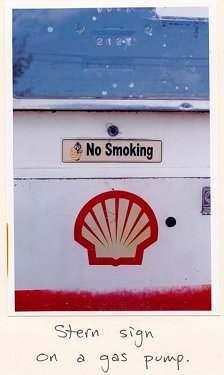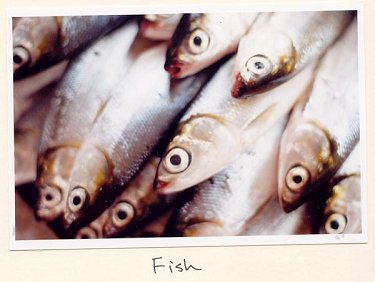|
|
Callan Bentley Philippines |
|
Back to Manila
Back to Manila
A few days later, I left the island of Panay. Noah and I left a neighbor in charge of the nipa hut, and we took a fantastically crowded bus to Kalibo. This time, though, we were riding “first class”: that is, INSIDE the bus rather than clinging to the roof. Once in Kalibo, we made some impromptu travel arrangements and caught our Cebu Pacific flight with about a minute and a half to spare. On board, the stewardesses entertained us by facilitating a serious of games of skill. The contest involved tossing small hoops onto a peg. Whichever passenger scored the most ringers, won a Cebu Pacific umbrella. Runner-up took home a tee-shirt.
Finally, there were a few final days in hyper-urban Manila before leaving. My perspective had changed during my time on Panay. The more rural southern island had a more relaxed atmosphere to complement its ecological bounty. Manila, by comparison, was deficient in both charm and natural wonder. I had not felt this revulsion as completely when I first arrived in Manila several weeks previously. Then, of course, my context for comparison had been Washington, DC. Used to urbanity, the basic substrate of the Philippine capital had not shaken me so deeply. Now I was arriving with a fresh view, knowing what wonders this spot had once held. I could see trash and broken slag where there had once been lianas and hornbills. It’s a shame Manila has been as ruined as it is. From the shards of glass atop the pitted road to the tangle of electrical wires crisscrossing overhead, and the filmy pollution that pervades all the area in between, Manila has gone to hell. It’s really a rough town, full of stereotypical Third World squalor. I went to one of the enormous shopping malls, dazed by an onslaught of color and patterns and Tagalog exhortations to buy. I was dropping off some film to be developed, but I’ll admit to basest sightseeing as well. Little differences, things you would never see in an American shopping mall: A cart selling squid balls. A Dunkin Donuts located next to a storefront church. A pimp offering up nice Filipina girls. Walking back to the Pension, I passed the Manila Zoo, which is walled in concrete four meters high, painted with crude images of African beasts. An unholy smell came wafting over the top: dead zebra perhaps. Noah had warned me not to go into that Zoo if I wanted to maintain any kind of positive outlook on the world. The conditions of the humans in Manila are duplicated among the captive menagerie. Disease and claustrophobia prevail. Down the street further, I found a tableau of pure comedy: A police cruiser, run halfway up onto the curb, propped up with boulders of cement where three of its wheels were missing. The hubs were rusted and bare. A series of scrapes and dents left the side panel and bumper with a lacerated appearance. The empty car still bore the proud motto of the Police Department on its skewed door: “Manila’s Finest.” It had been abandoned in front of a red and white “No Parking” sign. I read the newspapers. One carried the news that the leader of the Filipino Muslim separatist group, Abu Sayyef, had been captured by the National Army. I wonder at retaliatory strikes by the guerillas against Americans. If they beheaded a tourist before, what will they do now? I also read of a vicious crackdown by police on smugglers at the Port. Instead of arresting the perpetrators, they shot them. A front-page photo shows in the foreground two officers, slinging a body along. In the background, a truck with a neat row of bulletholes stitched across the windshield. Brutal justice, I thought. Sitting in the coffeehouse on the day before I leave, I pass the newspaper on to Noah. It’s been great to be here with him these past few weeks. I’ve spent more time with him on this trip then I have ever before, or possibly ever will again. Most of that has been quite positive, and his indefatigable spirit has carried me along with its energy to adventures I might never have attempted by myself. This is the way to visit a new place: with a guide who knows the land, but who also knows your own cultural needs. I walk the streets, browsing the open air markets, photographing the colorful fish and fruits, avoiding the crowds, nodding at the endless litany of “Hey Joe!” The pollution of the streets disgusts me. Used as I have become to staring into the rainforest for the minutest visual sign of birds and insects, I am picking up details of the litter that I wish I weren’t. A milky liquid sits foul and stagnant in the undrained gutters. I step carefully to avoid upsetting a pile of chicken carcasses and what appear to be rusted umbrella parts. Next to it is a puddle where it smells as if men have been pissing all night. Further, someone has laid a wet turd in a Styrofoam container. The placement of the feces where an entrée ought to be turns my stomach. Making sure of my footing, I look up. Past the crosshatching of wires, past the haze of auto exhaust, there are puffy cumulus clouds high up there. Hope, after all. And again I notice, there’s a security guard for every doorway in Manila. What will these people do for work if their domestic terrorism situation is resolved? There are certainly plenty who have no job and no hope even today. Like any city, Manila carries a stylish population of chic ladies in skirts and short hair, men wearing sunglasses and sideburns. But the number of homeless is staggering. Destitute and wearing scraps of trash, these poor people sleep on the sidewalks, with pedestrians walking by inches from their faces, day and night. It’s a horrible way for a man or a woman to live.
More rumblings about the ravaged city
The brutality continues. In comparing the Philippines to other Asian countries that I have visited, like Thailand, I see some striking differences. The Thais seem to have a much more deeply-rooted sense of pride, whereas the Filipinos do not. A base machismo is all that is mustered. Thailand, for instance, bans the import of pornography and the export of Buddha images: it has values, standards. The Philippines wages war on terrorists that spring forth from its own people. Every elected official in the Philippines seems to be battling charges of corruption. Here in Manila, huge piles of trash disfigure the sidewalks and luxury hotels print up their advertisement signs on the backs of old rice-sacks. Tinny disco music ripped off from another culture prevails in the clubs and on taxicab radios.
The individual people that I met in the Philippines were often lovely, of course: Lolo and Lola, for instance, so generous and genuine. But the country as a whole seems to be fractured and nonfunctional. Compared to the smooth operation of beatific Thailand, the Philippines seems to have its head up its arse. The obvious ineffectualness of the government is masked by a bully’s swagger. Big talk from a culture with deep insecurities. Headlines in the newspaper on another day gloat how another nine smuggling suspects were killed at the Manila Port. The Philippines seem almost adolescent as a nation: gawky, awkward, unaware of its place in the world. Over-reaction is the status quo. I cannot help but compare it to Thailand: calm and confident, time-tested and never colonized, sitting contemplatively like the Buddha himself. The Philippines has three doses of national identity crisis that they cope with. First, there are the problems with its disparate nature as an archipelago nation. Too many cultures, too difficult to bring pervasive unity to 7000 separate islands using close to 200 languages. Neighboring Indonesia suffers this even worse: an amalgam of islands and cultures even more fractious than the Philippines. Second, there is the legacy imposed by the Spanish when Magellan first claimed the islands in 1521. The Spanish left the Philippines with Catholicism and the legacy of a national identity, of unification. Even the name of the country is derived from King Philip II of Spain. Third, the US itself is responsible for a period of colonization, from 1898 to 1946. I attribute to my own nation the roots of the sleaze and money-grubbing, corner-cutting, anything-for-a-price attitude. When volatile ideas come into contact with unvaccinated cultures, strange evolutions result. I believe that is what has led to the bizarre dichotomy visible in downtown Manila today: towering shopping malls larger than the villages of Pandan and Cubay combined, surrounded by a gray urban wasteland of broken buildings, broken police-cars, and the broken people who pin their few remaining hopes on the potential of their nation.
The End
That's it for this trip. Thanks for taking the time to read it all.
| |||||||||||||||||||


